Top Employee Incentive Ideas to Boost Engagement
Boost employee engagement with our ultimate list of incentives. Explore bonuses, paid time off, and wellness perks! Click for actionable ideas.
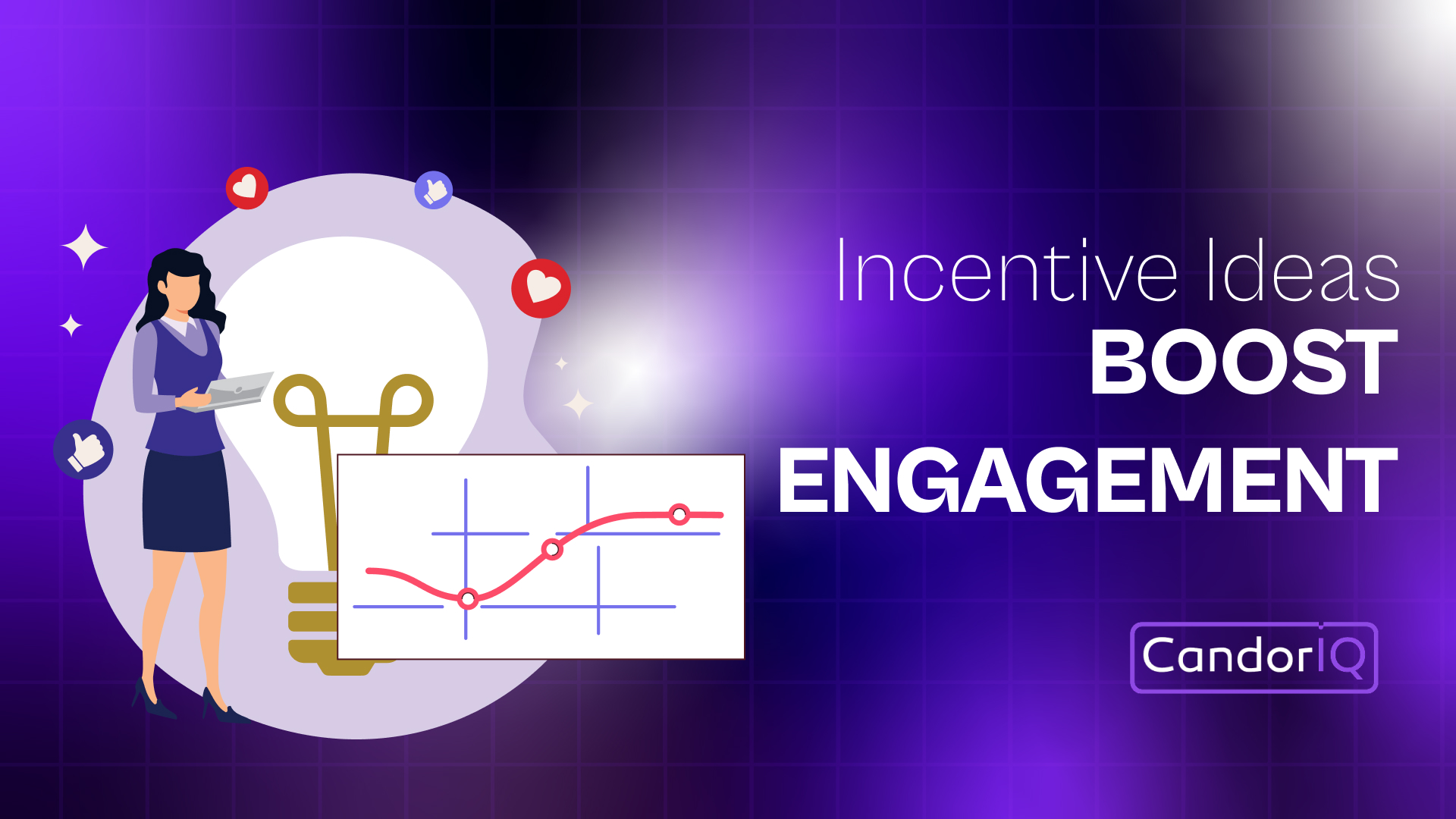
Traditional bonuses and end-of-year awards no longer carry the same weight. The modern workforce is hybrid, diverse, and more vocal about what it expects from employers. A paycheck alone doesn’t cut it anymore.
Employees want to feel seen, supported, and connected to their work. When incentives are intentional and well-executed, they do more than just motivate; they improve performance, reduce attrition, and build stronger teams. In fact, a meta-analysis found that well-structured reward programs can increase employee performance by 27 percent.
This blog lays out incentive ideas that go beyond cash. Whether your team works remotely, on-site, or in a mixed model, these examples are designed to help build a culture of recognition and accountability.
TL;DR (Key Takeaways)
- Cash alone isn’t enough. Today’s employees want flexibility, recognition, growth, and purpose; not just bonuses.
- Mix matters. A balanced incentive plan includes monetary rewards, non-monetary perks, and shared experiences that reflect both individual and team contributions.
- Customization is key. Incentives should be tailored by role, career stage, and work model. What works for sales may not work for engineering.
- Design with intent. Use employee feedback, align with company culture, and iterate using performance and engagement data.
- Pitfalls to avoid: one-size-fits-all rewards, lack of transparency, ignoring non-monetary motivators, and failure to track impact.
Why Incentives Matter for Engagement
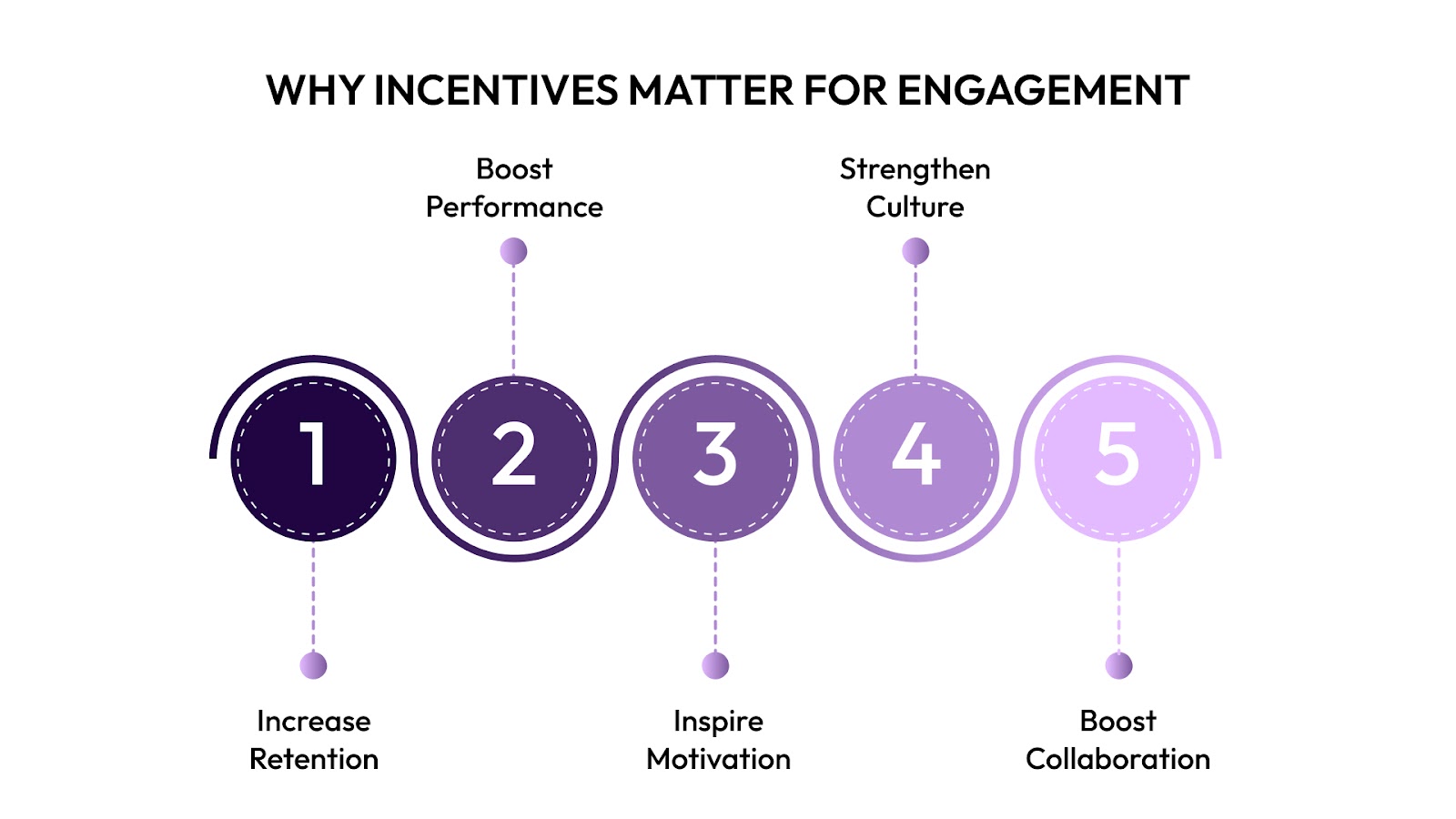
Incentives are more than just rewards. When designed well, they shape how employees perceive their work, how motivated they feel, and how loyal they remain. Good incentives support the larger employee experience; reinforcing the idea that effort and outcomes are noticed and appreciated.
Here’s why they matter:
- Reduce attrition and build loyalty: Employees who feel their contributions are valued are far more likely to stay. Retention improves when people know their efforts are seen and rewarded.
- Drive measurable outcomes: Tying recognition to specific goals or results reinforces high-performance behaviors and makes it easier to scale success across teams.
- Support intrinsic motivators: Rewards that reflect autonomy, mastery, and purpose (rather than just money) often lead to stronger long-term engagement.
- Strengthen company culture: Incentives that align with your core values send a clear message about what matters most and reinforce those behaviors across the organization.
- Encourage collaboration: Team-based rewards foster shared accountability and can reduce silos by making success a group effort.
Well-structured incentives do more than motivate. They help connect day-to-day work with business outcomes in a way that feels personal and meaningful. Once the foundation is clear, the next step is identifying incentives that still deliver value. Monetary rewards remain relevant when used intentionally.
Monetary Incentive Ideas That Still Work (When Used Right)
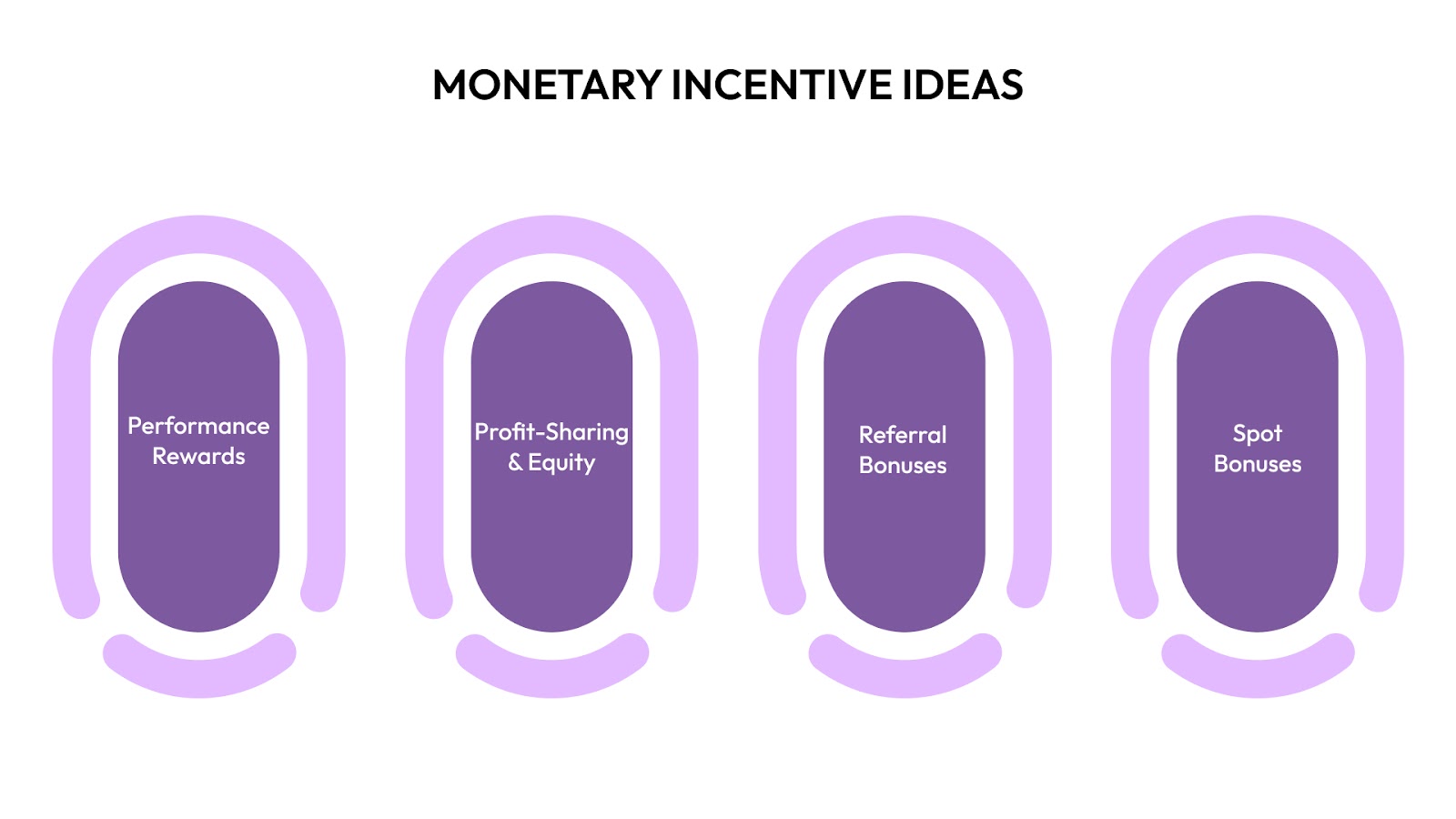
While the modern workforce values more than just a paycheck, monetary rewards still hold weight especially when they are timely, transparent, and tied to clear outcomes. When aligned with performance and communicated clearly, they reinforce accountability and achievement.
Here are some proven monetary incentive formats:
Performance-Based Bonuses
Bonuses tied to specific outcomes such as quarterly sales targets, successful project delivery, or operational KPIs. These can be structured as:
- Quarterly or annual bonuses
- Goal-specific payout slabs (e.g., 70%, 100%, 120% target achievement tiers)
- Team-based bonus pools for collaborative efforts
Profit-Sharing and Equity Options
For long-term motivation, companies often offer employees a share in profits or equity. Common structures include:
- Annual profit-sharing payouts based on company performance
- Restricted Stock Units (RSUs) or stock options with vesting schedules
- Employee Stock Purchase Plans (ESPP) at discounted rates
Referral Bonuses
Encouraging employees to refer candidates helps fill roles faster and builds a stronger culture. Common formats:
- Flat bonuses for each successful hire
- Tiered amounts based on the role's seniority or criticality
- Split payments (e.g., half at joining, half after probation)
Spot Bonuses
Small, spontaneous cash rewards given for exceptional efforts or contributions. These are typically:
- Delivered as prepaid gift cards or digital wallets
- Recognized publicly via email or town halls
- Budgeted monthly or quarterly to allow real-time recognition
These financial incentives may not replace meaningful work or good leadership, but they’re strong supporting tools when aligned with clear criteria and delivered consistently. Next, we’ll look at non-monetary rewards that often deliver equal or greater impact.
Non-Monetary Incentives with High Impact
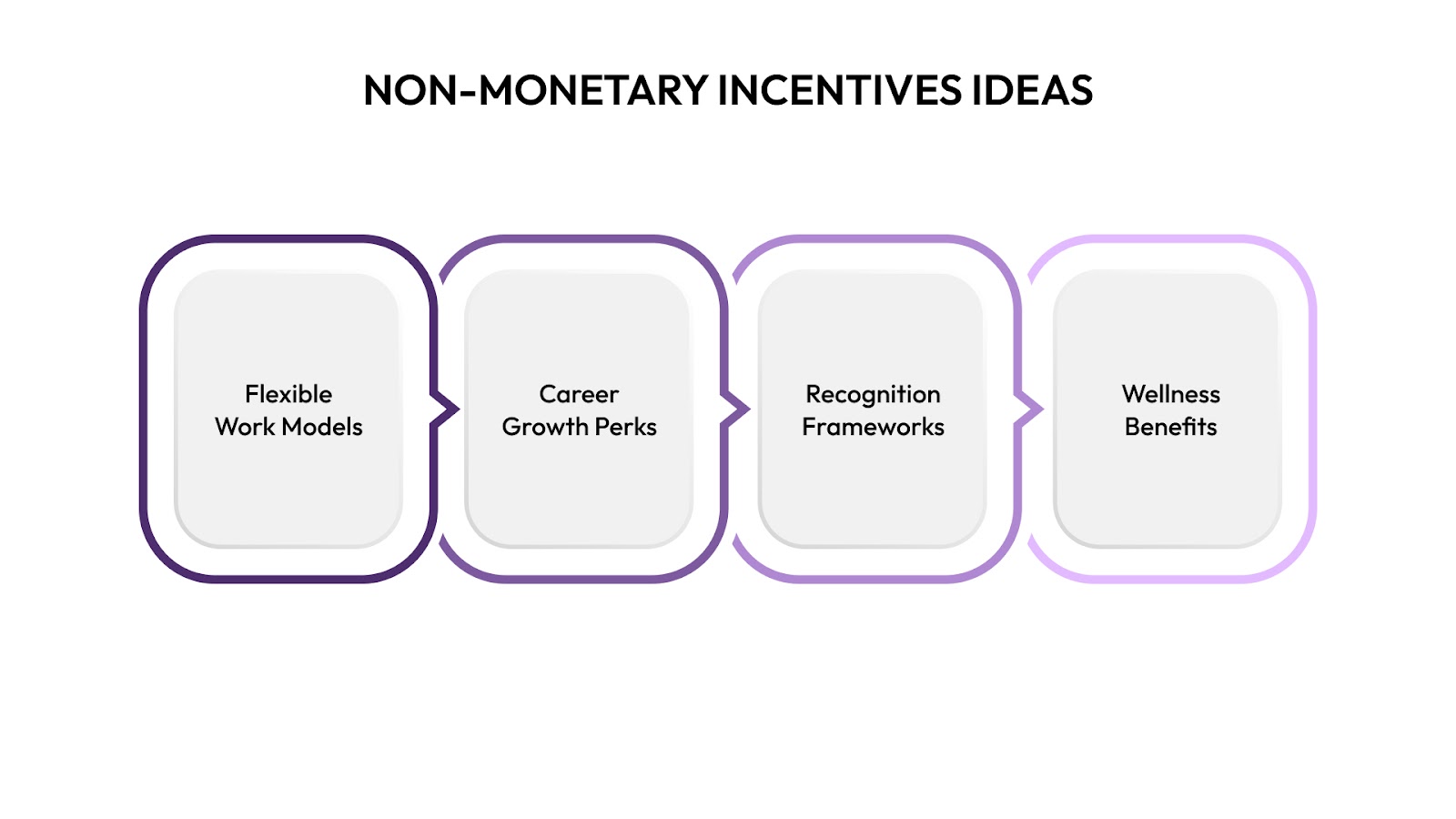
Monetary rewards matter, but they aren't the only motivators. Non-monetary incentives often create a stronger emotional connection between employees and the workplace. They show people that their time, health, and growth are priorities, not just their output.
Flexible Work Models
Giving employees control over how and where they work increases satisfaction and lowers burnout.
Examples:
- Four-day workweeks without reducing salary
- Remote-first or hybrid options based on role
- Asynchronous work schedules to accommodate time zones or focus blocks
Career Growth Perks
Professional development opportunities show that the company is invested in long-term careers, not just immediate output.
Examples:
- Annual learning stipends for courses, conferences, or certifications
- Sabbaticals after a defined period of tenure for skill-building or rest
- Mentorship programs to support internal mobility
Recognition Frameworks
Consistent and meaningful recognition helps reinforce positive behaviors and a culture of appreciation.
Examples:
- Monthly peer-nominated awards
- Public recognition via internal communication tools
- Leaderboards for cross-functional contributions
Wellness Benefits
Investing in employee health contributes to lower absenteeism and higher productivity.
Examples:
- Gym or wellness app reimbursements
- Mental health support through therapy stipends or access to digital health platforms
- Extra mental health days built into the annual calendar
Beyond individual rewards, shared experiences and purpose-driven perks can strengthen team culture and connection.
Experiential and Team-Based Incentives
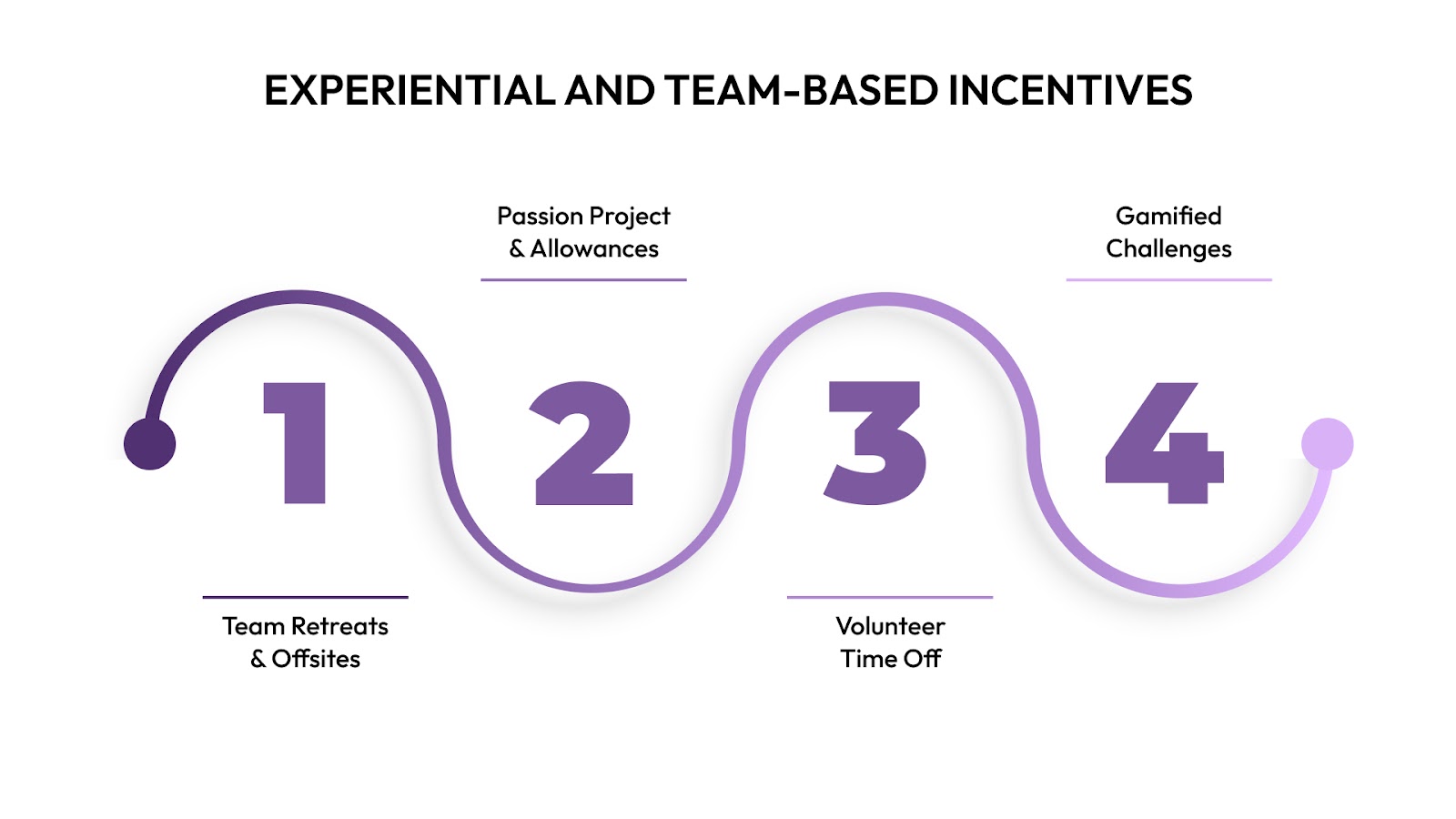
Not every reward needs to be tied to individual output or monetary value. Shared experiences and purpose-driven activities often deepen relationships, strengthen company culture, and create lasting memories. These types of incentives help employees feel part of something bigger than their to-do lists.
Team Retreats and Offsites
Bringing people together outside of the usual work environment encourages better collaboration and stronger personal bonds.
Examples:
- Annual strategy meetups at offsite locations
- Departmental retreats focused on team-building activities
- Outdoor workshops or hackathons for creative problem-solving
Passion Project or Hobby Allowances
Giving employees time or budget to explore personal interests can recharge creativity and boost morale.
Examples:
- Quarterly budget to pursue hobbies like painting, photography, or music
- “Build weeks” where employees can work on non-core passion projects
- Subsidies for creative tools or classes unrelated to work
Volunteer Time Off (VTO)
Employees increasingly value purpose and impact. Paid time to support causes they care about reflects shared values.
Examples:
- Two days a year for volunteering at a charity of their choice
- Team-based volunteering events tied to company CSR goals
- Matching volunteer hours with company donations
Gamified Engagement Challenges
Inject fun into the workday with light competition that fosters involvement across departments.
Examples:
- Company-wide wellness steps challenge with team prizes
- Innovation contests where employees pitch internal improvements
- Peer-recognition bingo to encourage daily shoutouts
Now that you have the ideas, the next question is how to structure a mix that actually fits your people and your goals.
How to Design the Right Incentive Mix
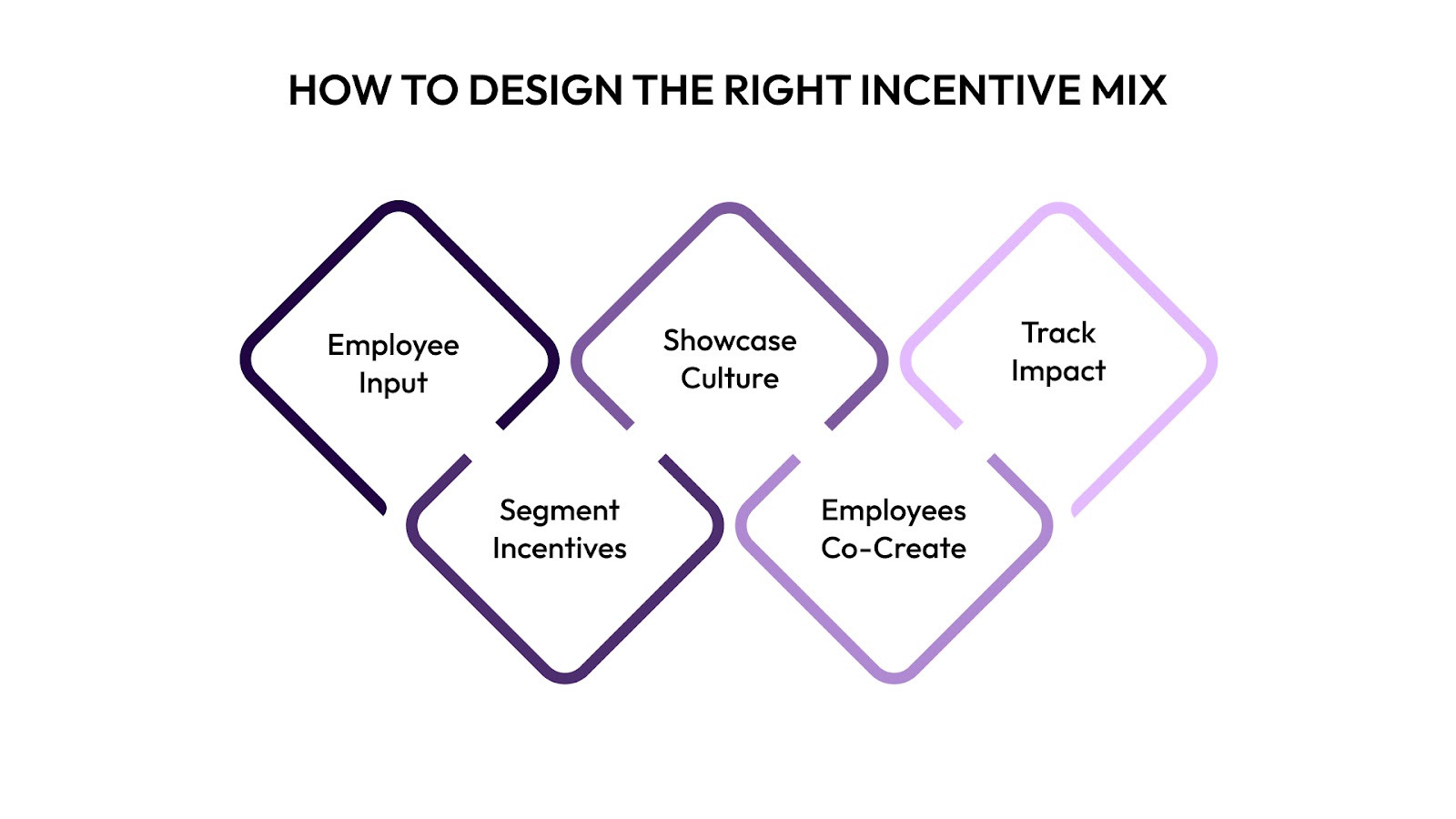
The best incentive programs reflect both employee preferences and business goals. They are not built on assumptions but shaped by feedback, data, and the culture of the organization. A thoughtful mix balances monetary and non-monetary rewards, short-term impact, and long-term motivation.
1. Use Employee Input
Start by collecting feedback through short surveys, suggestion boxes, or pulse polls. Focus on preferences rather than assumptions.
Example:
Survey questions might ask:
- Would you prefer extra time off or a one-time bonus?
- Do you value public recognition or private feedback more?
This helps you avoid designing programs that miss the mark.
2. Segment Incentives by Role and Persona
Not all teams respond to the same motivators. A sales team might value cash rewards while a product team prefers learning opportunities.
Example:
- Sales: performance bonuses, milestone dinners
- Remote workers: home office stipends, asynchronous flexibility
- New parents: childcare support or phased return options
- Entry-level staff: mentorship hours and certification vouchers
3. Align with Company Culture
The best incentives feel natural in the context of how your company operates. An overly formal reward system may not work in a casual, collaborative culture.
Example: A creative agency might favor "team playlist Fridays" or budget for side projects over traditional awards ceremonies.
4. Invite Employees to Co-Create
Involving employees in designing incentive programs improves both adoption and impact.
Example: Let teams vote quarterly on one new incentive to trial, such as a wellness budget, themed team lunch, or surprise days off.
5. Measure and Iterate with the Right Tools
Incentives should be monitored like any other business strategy. Use platforms like CandorIQ to connect performance data with reward usage and outcomes.
Example: Track how often spot bonuses are given and whether certain teams are underrepresented. Adjust policies to maintain fairness and visibility.
Before rolling out your program, it’s important to understand what can go wrong. These are some common pitfalls to look out for.
Mistakes to Avoid
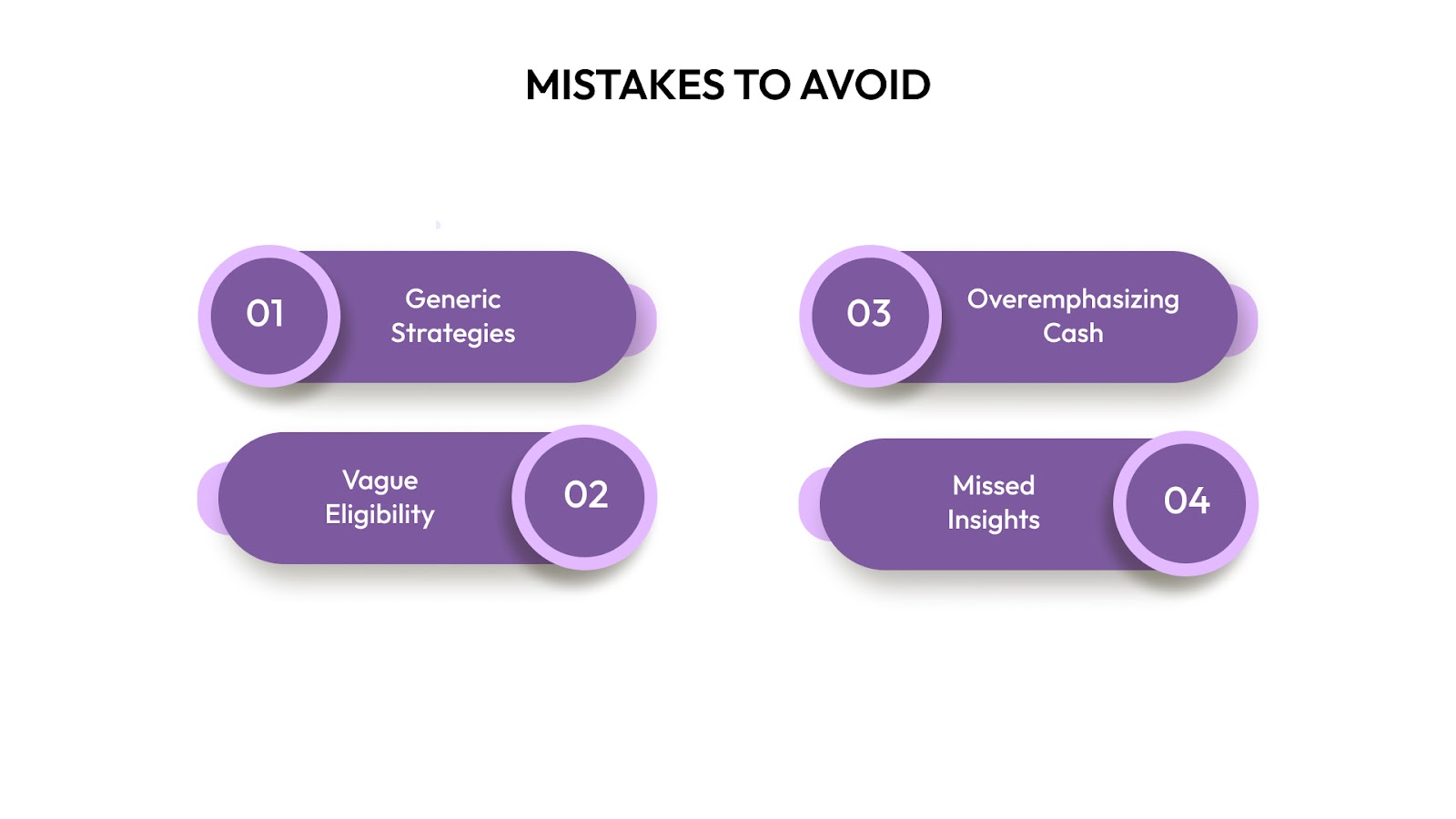
Even well-designed incentive programs can fall short if a few key pitfalls aren't addressed:
1. Relying on One-Size-Fits-All Approaches
Not all employees are driven by the same motivators. Applying a single incentive model across different roles, levels, or locations can limit impact. Tailor incentives based on team structure, goals, and feedback.
2. Being Vague About Eligibility or Timing
When employees don’t understand how to qualify for an incentive or when it will be delivered, it reduces trust and effectiveness. Communicate timelines, criteria, and reward mechanisms clearly.
3. Overemphasizing Cash Alone
Cash incentives matter, but non-monetary drivers like flexibility, recognition, and purpose often have longer-lasting effects. A balanced approach creates deeper engagement.
4. Failing to Measure and Evolve
If the impact of your incentive strategy isn’t tracked, it becomes hard to improve or justify. Platforms like CandorIQ help track engagement metrics, link rewards to performance data, and adjust programs in real time ensuring your strategy stays aligned with both employee needs and business goals.
A good incentive strategy is not just about offering more. It’s about offering the right things in the right way, backed by insight and intent.
How CandorIQ Helps You Get It Right
Mid-sized companies with lean HR and finance teams need more than spreadsheets. CandorIQ provides transparency, structure, and equity by consolidating all compensation and workforce planning into one platform.
- Align pay bands, headcount forecasting, and incentive planning in one system.
- Enable real-time collaboration across HR, Finance, and leadership.
- Support geo-adjusted pay, variable compensation, and equity modeling.
- Track reward effectiveness using built-in analytics.
- Eliminate disjointed tools and elevate HR as a strategic function.
Companies use CandorIQ to ensure fair pay, align workforce plans with budgets, and reduce miscommunication across departments, especially useful for organizations managing distributed teams and rapid growth.
Conclusion
Companies use CandorIQ to ensure fair pay, align workforce plans with budgets, and reduce miscommunication across departments, especially useful for organizations managing distributed teams and rapid growth.
Incentives today go beyond perks. They are part of how you compete for talent, build culture, and scale performance sustainably. If you are a CPO, CFO, HRBP, or recruiting leader in a growth-stage company with 50–5,000 employees, now is the time to rethink your approach.
CandorIQ helps you design and manage incentive programs that are fair, aligned, and data-driven; giving you clarity without spreadsheets and visibility across your entire workforce.
Ready to move from manual tracking to a unified reward strategy? Book a demo to see how CandorIQ can help you streamline planning, improve equity, and engage your team at scale.
Frequently Asked Questions
Q: What are some effective non‑monetary employee incentives?
Ans: Flexible hours, learning stipends, recognition platforms, wellness benefits, and team retreats are top choices. Employees appreciate perks that support well‑being, growth, and autonomy.
Q: Which monetary incentives drive the best engagement?
Ans: Performance‑based bonuses, profit‑sharing, referral rewards, and spot bonuses can boost results when they are timely, transparent, and tied to clear outcomes.
Q: How do I choose the right mix of incentives for my team?
Ans: Start with employee surveys to understand preferences. Segment by role, seniority, and work model. Combine monetary and non‑monetary incentives that match your company culture and values.
Q: How should I measure the success of an incentive program?
Ans: Track key metrics like retention, productivity, performance ratings, and bonus distribution. Use tools to monitor trends, disparities across teams, and ROI over time.
Q: What mistakes should be avoided in incentive planning?
Ans: Avoid these pitfalls: one‑size‑fits‑all programs; unclear criteria or timing; focusing only on cash; and failing to review or adapt based on data and feedback.
Q: Can small teams manage incentive programs effectively?
Ans: Yes. Even lean HR or People teams can run structured incentive programs. Start with a pilot, gather feedback, and iterate using simple tools before scaling up.


